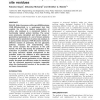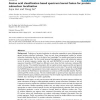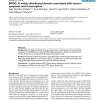32 search results - page 4 / 7 » Predicting conserved protein motifs with Sub-HMMs |
NAR
2007
13 years 9 months ago
2007
PAR-3D (http://sunserver.cdfd.org.in:8080/protease /PAR_3D/index.html) is a web-based tool that exploits the fact that relative juxtaposition of active site residues is a conserve...
BMCBI
2006
13 years 9 months ago
2006
Background: Members of a protein family often have highly conserved sequences; most of these sequences carry identical biological functions and possess similar three-dimensional (...
BMCBI
2010
13 years 10 months ago
2010
Background: Prediction of protein localization in subnuclear organelles is more challenging than general protein subcelluar localization. There are only three computational models...
BMCBI
2005
13 years 9 months ago
2005
Background: The multitude of motif detection algorithms developed to date have largely focused on the detection of patterns in primary sequence. Since sequence-dependent DNA struc...
BMCBI
2004
13 years 9 months ago
2004
Background: The Split ends (Spen) family are large proteins characterised by N-terminal RNA recognition motifs (RRMs) and a conserved SPOC (Spen paralog and ortholog C-terminal) d...




